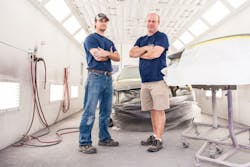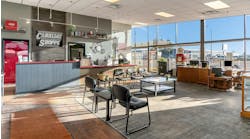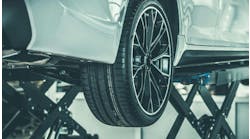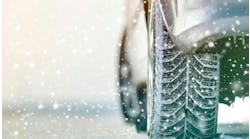Because of well-honed standard operating procedures and an unwavering trust in his long-term employees, Jeff Cotten’s two Virginia shops—Masters Auto Body in Charlottesville and Masters Collision Center in Goochland—run just fine without him. Now at his third location, Collision Masters in Myrtle Beach, S.C., Cotten is able to focus on what he loves—fixing cars.
As long as you have a standard operating procedure, you’re going to get the same results every time. Those are the things that I developed over the years of working in the shop.
In January 1982, I opened Masters Auto Body, my original shop in Charlottesville, Va. I rented a basement of an old Saab dealership, and I started with just myself. I began building my customer base and I hired a few more employees and grew out of the space by 1985.
I bought property in Charlottesville and built a 5,000-square-foot facility that I thought would be more than adequate for what I needed.
We learned how to use our small space effectively, and we were able to produce quite a bit of work per square foot as compared to the national average. I believe we were doing about $15 per square foot. That’s a lot of work out of a small shop. Revenue moved up to $2 million a year about 10 years ago at the Charlottesville location.
One of the keys to our success was exceeding the customer’s expectations. I know that if you can give the customer more than they’re expecting and communicate well with them and give them back a quality product, they’ll be customers for life. They’ll tell all their friends about you, and that’s how we’ve been successful.
The efficient system that we’ve incorporated into the shops—our standard operating procedures—are vital to turning out a quality repair every time.
I’m not a hands-on manager when it comes to my original location. The people that I left there at Masters Auto Body have been with me for years. I have very little turnover. I’ve got a bunch of employees that have been with me for more than 15 years.
I was able to break my daily ties from the shop and allow my employees to be able to run it on their own.
I joined a 20 group in 1998. That’s when I started developing our SOPs. For example, I drafted an SOP for our blueprinting process. When a car comes in, a technician completely tears it down, identifying the parts that are on the estimate versus the ones that are supplemental. When the teardown is done, we’re able to write a complete supplement, contact the insurance company and get the approval for all the additional work.
Part of our SOPs came out of necessity. For example, now we take pictures every time a car comes in the shop. We take a picture of the dash and that will give us the mileage, the fuel level, and any lights that are on. If there’s a light on that we think might be related to the accident, we call the customer, and then we call the insurance company.
The SOPs simplify the process, allowing the cars to go through without incident.
And my employees have been trained in those SOPs. They benefit the employees as much as they do the owner. My employees are paid on a flat rate. The more productive they are, the more money they make. So the smoother the jobs can go, the better it is for all.
Over the last four years, revenue at Masters Auto Body has stayed steady between $2.2 and $2.4 million, and that shows me that my employees are sticking to the procedures we have in place.
I don’t sit up there and tell them how to run the shop, because they know how to run the shop on their own. My philosophy is if they ruin it, then they don’t have a job either.
My second shop is just a little country shop. We have four employees. We opened in March of 2011. My staff there follows the same procedures and the shop was quickly off and running with little help from me. And then when this opportunity down in Myrtle Beach, S.C., came up, it was easy to take the next step. I already had a condo down here that I use for a vacation home. I like Myrtle Beach. I like the climate. I like the water.
A 5,000-square-foot building became available right up the street from my condo on the main U.S. Hwy. 17, and I put together a lease with the owner. It took about three months to get the building ready.
We opened our doors Feb. 27, 2012. Basically all my time is spent there.
These days, my daily routine is pretty simple. I get here between 7:30 and 8 a.m. Unlike at my other locations, I’m hands-on in the Myrtle Beach shop. It’s a personal preference; one I couldn’t make until now because I was concentrating on growing the business. I don’t thrive as well in the office environment, because I like to fix things. I like to be out in the shop fixing cars. I’ll let somebody else handle the paperwork. I’m a production guy.
I try to juggle the jobs and do them in the proper order, so that they’re done on time.
The standard operating procedures we have are still my strong point. But now instead of helping another one of my shops run independently, they help me run this one effectively. Before I opened the doors to the third shop, I had complete written standard operating procedures on how I wanted to do it all—everything from the perspective of me working in the business.
I’m very flexible with my staff, and I think that’s one of the keys to my success in having long-term employees. I give them a place that they love to work. It makes for a happier work environment.
We lock our doors at 5 p.m. We usually work until 5:30 or 6 at least; sometimes 7 at night just to get the work done.
I do like it the best in the shop. Down the road it may change, when we have a larger shop, I expect to be busier, where there’s more need to be involved in dealing with customers and insurance companies.
I could be a go-between then. But right now, I’ve dusted off my tools and greased the wheels on my jacks, and I’m fixing cars.



